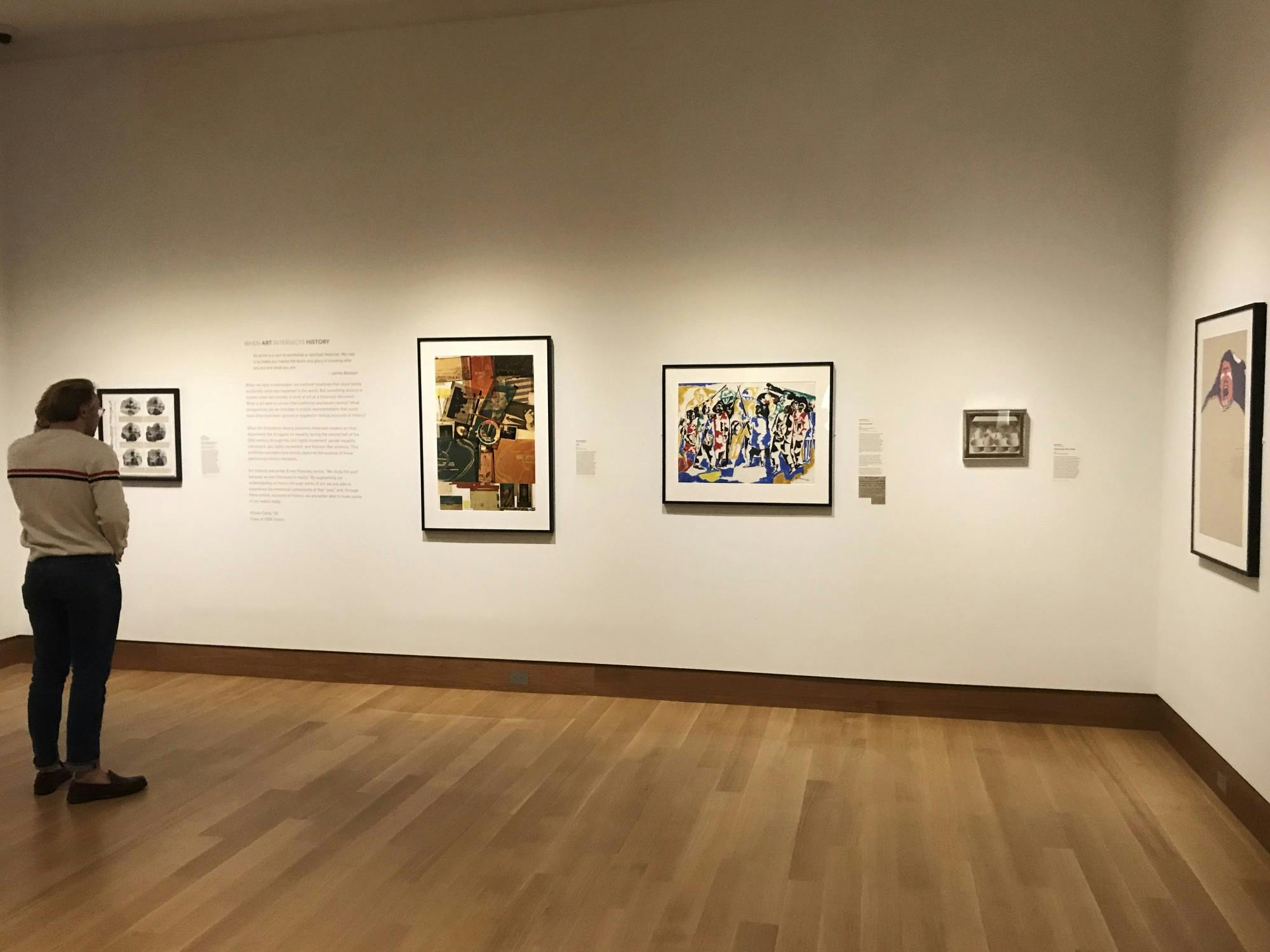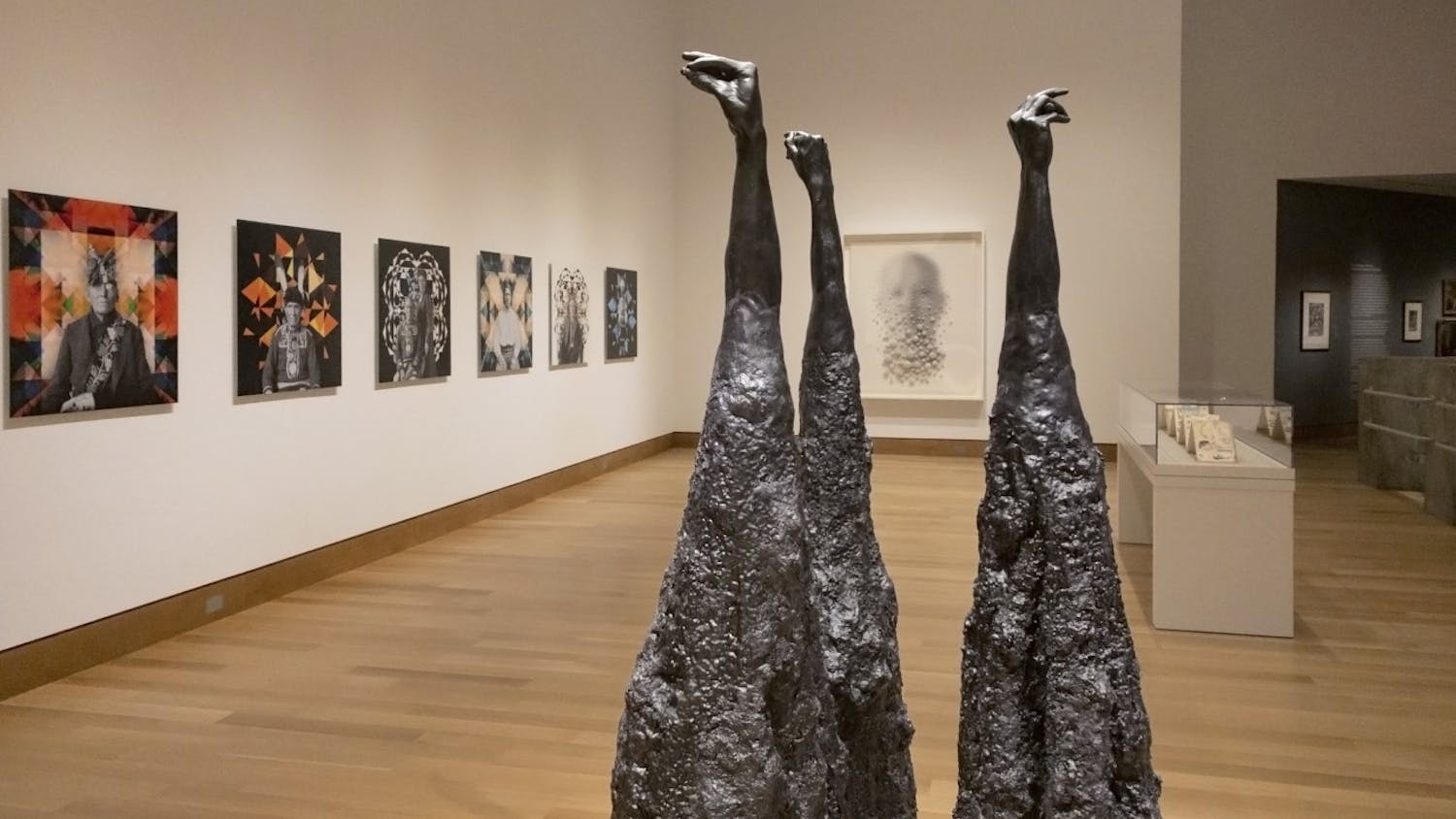Curatorial intern Allison Carey ’20’s exhibit “When Art Intersects History,” which opened in the Hood Museum of Art on March 7, focuses on 20th-century art that adds additional color and dimension to historical struggles for equality.
The exhibit, which closed to visitors soon after its opening due to the outbreak of COVID-19, is part of the Hood’s “A Space for Dialogue” series, according to associate curator of academic programming Amelia Kahl ’01. She said the project allows student interns like Carey to curate their own exhibits from the museum’s extensive collection. Carey’s exhibit focuses on the 1960s and 1970s, using art to provide insight into the civil rights, gender equality and anti-Vietnam war movements.
Carey, who supplemented the exhibit with contemporaneous historical headlines from The Dartmouth, said that art enhances the story told by objective newspaper articles.
“I am trying to say that the past is tempered by vast differences in perspective and place,” she said. “When we look at art, it is not bound by facts and the objectivity of text, there is more room for an emotional survey of what is happening; art is an emotional experience.”
Carey said her favorite piece in the exhibit is a 1996 lithograph by the Guerrilla Girls, entitled “How to Enjoy the Battles of the Sexes.” The Guerrilla Girls were founded in 1985 to question gender and racial inequality in the art world, using political collages and sarcastic texts to make bold statements about the history of exclusion, according to Carey.
The Guerrilla Girls layered their iconic gorilla mask symbol over ancient Greek images of women fighting men, Carey said. Red scribbles on the image read “Women don’t need to be afraid of being lonely at the top, because they will never get there.”
Kahl described intern exhibits like Carey’s as a chance for students to showcase their original ideas and scholarship, adding that the relevance of Carey’s exhibit to current events is evident.
“Thinking about her show makes me think about what kinds of artistic reflections we are going to see about COVID-19, and what artistic meditations we will see about this moment of police brutality and protest,” Kahl said.
One piece in the exhibit that stood out to Kahl was a small George Tooker painting from 1963 entitled "Half-Dozen Eggs (Carton of Eggs),” which depicts a partially-filled carton of brown and white eggs.
“It is a metaphor for folks of different colors existing together,” Kahl said. “[Carey] paired it with images showing school integration, among other, more dynamic images.”
Carey echoed Kahl’s sentiments on the quiet presence of the Tooker painting. She said the piece was created for a civil rights auction held in Hanover in 1963, with proceeds donated to the NAACP.
“It is a simple composition of brown and white eggs, but a powerful vision of a future of racial integration,” she said. “By putting brown and white eggs in the same container, Tooker seems to be suggesting that equality should be as commonplace as eggs in a carton: even an object study can have symbolic undertones.”
In addition to creating her exhibit, Hood curator of American art Barbara MacAdam said that Carey took on other responsibilities at the museum. She said Carey designed curatorial reports, cataloging objects and providing background information, and also helped to organize a career panel about alumni in the arts.
MacAdam, who is Carey’s supervisor at the Hood, described the installation as “handsome.” As her supervisor, she helped Carey work out the details of her exhibit through weekly check-ins.
In order to craft the exhibit, Carey said she worked with the Hood’s head of exhibitions design and implementation Patrick Dunfey. Together, Carey said the two considered wall colors, fonts for wall text and options for spacing the works of art, exploring ways in which to group themes and make the exhibit flow.
Carey said her exhibit includes pieces that respond to anti-Vietnam war protests, including a 1971 lithograph by Peter Saul entitled, “Shicago Justus.” According to Carey’s object label for the piece, the “cartoonish” work depicts Robert Seale, a defendant who faced riot incitement charges after the 1968 Chicago protests, which were later dropped. Carey complemented the piece with headlines from The Dartmouth’s coverage of the same unrest, which she said she uncovered through archival research in the Rauner Special Collections Library.
Carey also used excerpts from The Dartmouth to contextualize Fritz Scholder’s 1973 screen-print, “Untitled (Screaming Indian).” In the piece’s exhibit label, Carey wrote that the figure depicted in the piece’s tightly squinted eyes and gaping mouth showed a powerful cry.
“With no visible body, the suspended head could allude to greater themes of displacement or cultural loss,” she wrote. “Instead of presenting the noble savage stereotype that was commonly embraced in popular culture, Scholder depicts a man who is emotive and fragmented.”
Below the painting, Carey chose to display excerpts from a 1979 opinion article in The Dartmouth expressing dissatisfaction about minority treatment at the College. The article, penned by the Afro-American Society, Native Americans at Dartmouth and the Latino Forum, expresses the reasoning behind the public defacement of a Winter Carnival ice sculpture.
In the column, the students argued that the sculpture was “symbolic of the Dartmouth tradition that has excluded those who are not white males,” and implored the College to listen to their own “voice calling out in the wilderness.”
In addition to the newspaper excerpts, the artwork in the exhibit is complemented by Carey’s own explanatory texts. Kahl said that interns write an introductory text, individual object wall labels and an exhibit brochure, all of which are then reviewed by a professional editor.
Carey said she tried to keep her commentary apolitical and open-ended, adding that she wanted to create an environment for discussion, in the spirit of the idea of creating “A Space for Dialogue.”
Carey added that many of the works she included in her exhibit represent viewpoints she cannot personally relate to, so she did not want to tell anyone how to approach each piece.
“I didn’t want to get up there and say this is what it’s like to live this experience in America,” she said. “I tried to step away, write a description of what I saw and offer it as a jumping off point.”



